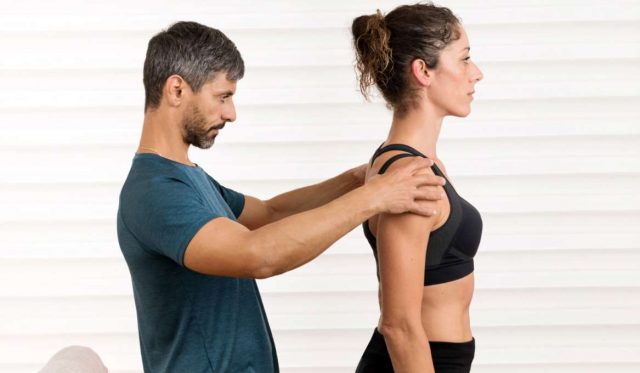With all the conveniences that accompany modern living, there are some important trade-offs. Now more than ever, sedentary living is contributing to the development of back issues for many people. Too much working and enjoying entertainment in front of screens leads to bad posture and many related health problems.
When you think of bad posture, you may be considering its appearance. But poor posture can impact your overall health in myriad ways. Posture is defined by the alignment of your joints relative to gravity, and to each other. Your body is designed to perform at its best and use less energy when all your joints are properly aligned. Yet, your day-to-day habits conspire to undermine healthy posture.
Many products, including back braces and corrective devices, have emerged on the market to address this problem. But do they actually improve poor posture and correct its associated health issues over time?
Typical Irregularities in Posture
The bones and joints in your body each have individual functions, yet they all work interdependently. They operate in coordinated sequences in a system called the kinetic chain, governed by muscle tension. When an irregularity in posture emerges anywhere along the kinetic chain, the body’s alignment is thrown off.
If someone were to suspend a plumb line from the center of your ear down your body’s side to the floor, it would ideally align with your shoulder and hip joints, run along the back of your kneecap, and fall just forward of your ankle joint. If your joints do not align in this way, your posture could use some improvement.
● Forward head posture
The system that keeps your head erect includes 7 cervical vertebrae that support your head and 20 small muscles that hold it in place. These structures work hard to stabilize and move your head, despite its 10-12 pound weight – similar to the weight of a bowling ball.
Forward head posture can develop when your cervical spine begins to curve forward, often as a result of hunching over your computer or using a mobile device for long periods of time each day. This can lead to headaches and TMJ syndrome.
● Kyphosis
Kyphosis is a condition that affects your upper back, causing your shoulders to slouch forward and affecting your thoracic spine. Poor posture can cause the kyphotic curve in your upper spine to become progressively more pronounced, causing you to appear older and preventing you from breathing properly. This can result in neck pain as well as degenerative disc disease. Kyphosis is common in older adults who suffer from osteoporosis.
● Lordosis (swayback)
Lordosis affects the lower back in the lumbar spine region. It is an exaggerated curvature that pushes the hips and pelvis forward and compresses the lumbar vertebrae. Too much sitting can cause lordosis, which is accompanied by weak core and abdominal muscles. Diminished tone in the glutes and hamstrings and tight hip flexors are also characteristic of lordosis, which is a leading cause of lower back pain.
● Flat back posture
Your natural lordotic curve is flattened as your pelvis and hips shift forward in the postural irregularity known as flat back posture. This often happens in people who stand for long periods of time each day, like college professors and people working in retail. Weak core and abdominal muscles are contributing factors.
When standing, people who develop flat back posture often clench their glutes, rest the weight of their upper body on their pelvic bowl, and allow their knees to lock. This posture is often accompanied by knee pain.
How Poor Posture Affects Overall Health
When your posture deteriorates over time, it reduces your ability to move efficiently. It makes you look weak, and adds years to your appearance. It also impairs your static and dynamic balance. (1)
How Suboptimal Posture Affects Overall Health
- Can lead to degenerative disc disease
- Reduces shoulder function
- Increases risk of injury during exercise
- Places excess pressure on the knees
- Leads to neck and back pain
- Diminishes breathing capacity
- Impedes digestion
- Decreases sexual function
- Interferes with bowel and bladder function
- Contributes to falls in older adults
- Makes you look older
- Causes low self-esteem
Devices that Claim to Correct Posture
Current times are a boon for businesses looking to sell medical devices. Lockdowns during the COVID pandemic and the explosion of remote work have led many people into more sedentary lifestyles that increase posture-related health problems.
To take advantage of this expanding market, manufacturers are creating and selling a wide range of postural correction tools. They include:
- Bras for back support
- Braces to correct forward head posture
- Devices for correcting neck posture
- Posture-correcting braces
- Braces to correct rounded shoulders
- Shoulder back braces
- Posture correcting straps
- Chiropractic posture braces
It would seem that these solutions could not have been created at a better time. However, back braces may not be as effective as their sellers claim, for several reasons:
- They tend to be uncomfortable to wear
- They are only effective when used consistently
- They don’t get to the root of the problem, which is poor posture and being out of shape
Do Back Braces Work?
Braces that aim to correct bad posture do not typically harm users, but they don’t always live up to the claims of their creators, either. Devices cannot address the underlying issues caused by connective tissues and muscles that are not adequately conditioned. Muscles can become even weaker when you wear a brace for too long because they do not have to work as they normally would.
Braces also do not address the problem of too-tight muscles, tendons and fascia. Muscle tension throughout the body has to be balanced to achieve good postural alignment. To improve posture, weak muscles need to be strengthened, and tight muscles need to be stretched.
Sitting for too long and failing to exercise regularly causes your posture to deteriorate, causing instability in key muscle pairs:
- Muscles that hold your head up become weak while those that flex it forward become stiff
- Internal shoulder rotators get stiff while external ones become weak
- Pectoral muscles develop tightness while the muscles in the upper back become weaker
- Ab muscles grow weak while lower back muscles get tighter
- Hamstrings and glutes become weak while hip flexors develop tightness
- Knee extensors grow weak and knee flexors become stiff
An effective workout program with walking, stretching, and resistance training should be implemented to recalibrate muscle alignment and achieve better posture. The plus is that you will look amazing, feel more vibrant, and reduce the risk of joint problems and injuries.
Physical Therapy to Improve Posture in NYC
Postural improvement devices and braces can provide a mental cue that makes you more aware of your posture. However, improving your overall physical fitness is the most effective way to achieve long-term improvement. To maximize your results, visit a chiropractor, physical therapist, or back pain specialist and improve your posture permanently.
When it comes to posture correction in NYC, NYDNRehab offers expert care based on extensive knowledge and experience. The clinic features a plethora of advanced tools and technologies to help expedite your healing process.
Don’t waste your time and money on braces and devices that fall short of addressing the root of your posture problems. Contact NYDNRehab today, and improve your posture for better health.





